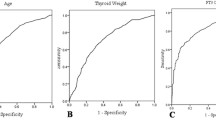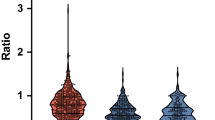Abstract
Purpose
This study evaluated the thyroidal kinetics of radioiodine in Graves’ disease under continued thiamazole medication and after discontinuation of thiamazole for 1–2 days, with a view to keeping the period of discontinuation as short as possible and to exploring the underlying mechanism of a postulated radioprotective effect of antithyroid drugs.
Methods
In 316 patients, diagnostic and therapeutic radioiodine kinetics were followed up for 2 days by ten uptake measurements each and were defined mathematically by a two-compartment model.
Results
Without thiamazole or when thiamazole was discontinued for at least 2 days, all uptake curves could be fitted perfectly by a simple in- and output function; the mean square error (mse) was 0.38 (test) and 0.28 (therapy). Under continued thiamazole medication (11.0±7.0 mg/day), the energy dose delivered to the thyroid was lowered by factor of 2.5. Uptake curves were deformed (mse: 1.06, test and 0.86, therapy) and appeared two peaked, suggesting coexistence of follicles with blocked and follicles with intact hormone synthesis and hence heterogeneous radioiodine uptake in the thyroid. In patients with maximally altered uptake curves, the success rate was as low as 31%. One day after discontinuation of thiamazole, mse was still increased (0.78, test), while 2 days afterwards it had normalised (0.36, test) and 3 days afterwards (mse: 0.24, therapy) the success rate was 87%.
Conclusion
Efficacy of radioiodine therapy under continued thiamazole medication is reduced not only by a lower uptake and shorter half-life of radioiodine, but also by a heterogeneous energy dose distribution in the thyroid. Discontinuation of thiamazole (but probably not of propylthiouracil) for at least 2 days is required to restore the efficacy of radioiodine.





Similar content being viewed by others
References
Urbannek V, Voth E, Moka D, Schicha H. Radioiodine therapy of Graves’ disease dosimetric comparison of different strategies concerning antithyroid drugs. Nuklearmedizin 2001;40:111–5.
Sabri O, Zimny M, Schreckenberger M, Reinartz P, Ostwald E, Buell U. Radioiodine therapy in Graves’ disease patients with large diffuse goiters treated with or without carbimazole at the time of radioiodine therapy. Thyroid 1999;9(12):1181–8.
Sabri O, Zimny M, Schulz G, Schreckenberger M, Reinartz P, Willmes K. Success rate of radioiodine therapy in Graves’ disease: the influence of thyrostatic medication. J Clin Endocrinol Metab 1999;84(4):1229–33.
Andrade VA, Gross JL, Maia AL. The effect of methimazole pretreatment on the efficacy of radioactive iodine therapy in Graves’ hyperthyroidism: one year follow-up of a prospective, randomized study. J Clin Endocrinol Metab 2001;86(8):3488–93.
Burch HB, Solomon BL, Cooper DS, Perguson P, Walpert N, Howard R. The effect of antithyroid drug pre-treatment on acute changes in thyroid hormone levels after 131I ablation for Graves’ disease. J Clin Endocrinol Metab 2001;86(7):3016–21.
Razvi S, Basu A, Mclntyre EA, Wahid ST, Bartholomew PH, Weaver JU. Low failure rate of fixed administered activity of 400 MBq 131I with pre-treatment with carbimazole for thyrotoxicosis: the Gateshead Protocol. Nucl Med Commun 2004;25(7):675–82.
Connell JM, Hilditch TE, Robertson J, Coghill G, Alexander WD. Radioprotective action of carbimazole in radioiodine therapy for thyrotoxicosis—influence of the drug on iodine kinetics. Eur J Nucl Med 1987;13(7):358–61.
Walter MA, Christ-Crain M, Schindler C, Müller-Brand J, Müller B. Outcome of radioiodine therapy without, on or 3 days off carbimazole: a prospective interventional three-group comparison. Eur J Nucl Med Mol Imaging 2006;33:730–7.
Brunn J, Block U, Ruf G, Bos I, Kunze WP, Scriba PC. Volumetry of the lobe of the thyroid gland by means of realtime sonography. Dtsch Med Wochenschr 1981;106:1338–40.
Dunkelmann S, Neumann V, Staub U, Kuenstner H, Groth P, Schümichen C. Results of a risk-adapted and functional radioiodine therapy in Graves’ disease. Nuklearmedizin 2005;44:238–42.
Rink T, Bormuth FJ, Braun S, Zimny M, Schroth H-J. Concept and validation of a simple model of the intrathyroidal iodine kinetics. Nuklearmedizin 2004;43:21–5.
Fischetti AJ, Drost WT, Dibartola SP, Chew DJ, Schenck PA, Meadows C. Effects of methimazole on thyroid gland uptake of 99mTc-pertechnetate in 19 hyperthyroid cats. Vet Radiol Ultrasound 2005;46(3):267–72.
Suzuki K, Lavaroni S, Mori A, Ohta M, Saito J, Pietrarelli M, et al. Autoregulation of thyroid-specific gene transcription by thyroglobulin. Proc Natl Acad Sci U S A 1998;95(14):8251–6.
Saito T, Endo T, Kawaguchi A, Ikeda M, Nakazato M, Kogai T, et al. Increased expression of the Na+/I− symporter in cultured human thyroid cells exposed to thyrotropin and in Graves’ thyroid tissue. J Clin Endocrinol Metab 1997;82(10):3331–6.
Ajjan RA, Kamaruddin NA, Crisp M, Watson PF, Weetmann AP. Regulation and tissue distribution of the human sodium iodide symporter gene. Clin Endocrinol (Oxf) 1998;49(4):517–23.
Spitzweg C, Joba W, Morris JC, Heufelder AE. Regulation of sodium iodide symporter gene expression in FRTL-5 rat thyroid cells. Thyroid 1999;9(8):821–3.
Ferreira AC, Lima LP, Araujo RL, Muller G, Rocha RP, Rosenthal D. Rapid regulation of thyroid sodium-iodide symporter by thyrotrophin and iodide. J Endocrinol 2005;184:69–76.
Clerc J, Kahn E, Fragu P. SIMS evidence that carbimazole enhances spatial heterogeneity of thyroid iodine storage and targeting in a woman with Graves’ disease. Cell Mol Biol (Noisy-le-grand) 2001;47(3):519–27.
Walter MA, Christ-Crain M, Müller B, Müller-Brand J. Radioiodine uptake and thyroid hormone levels on or off simultaneous carbimazole medication. Nuklearmedizin 2005;44:33–6.
Nakashima T, Taurog A. Rapid conversion of carbimazole to methimazole in serum: evidence for an enzymatic mechanism. Clin Endocrinol (Oxf) 1979;10(6):637–48.
Schneider P, Körber C, Körber-Hafner N, Hänscheid H, Reiners C. Does an individual estimation of half-life improve the results of radioiodine therapy of Graves’ disease? Nuklearmedizin 2002;41(6):240–4.
Bockisch A, Jarnitzky T, Derwanz R, Biersack HJ. Optimized dose planning of radioiodine therapy of benign thyroidal diseases. J Nucl Med 1993;34:1632–8.
Bogazzi F, Bartalena L, Campomori A, Brogioni S, Traino C, De Martino F. Treatment with lithium prevents serum thyroid hormone increase after withdrawal and radioiodine therapy in patients with Graves’ disease. J Clin Endocrinol Metab 2002;87:4490–5.
Groth P, Dunkelmann S, Staub U, Schümichen C. Stunning der Schilddrüse—ein Früheffekt der Iod-131-Therapie? Nuklearmedizin 2005;44:A103.
Braga M, Walpert N, Burch HB, Solomon BL, Cooper DS. The effect of methimazole on cure rates after radioiodine treatment for Graves’ hyperthyroidism: a randomized clinical trial. Thyroid 2002;12(2):135–9.
Hancock LD, Tuttle RM, Le Mar H, Bauman J, Patience T. The effect of propylthiouracil on subsequent radioactive iodine therapy in Graves’ disease. Clin Endocrinol (Oxf) 1997;47(4):425–30.
Imseis RE, Vanmiddelesworth L, Massie JD, Bush AJ, Vanmiddelesworth NR. Pretreatment with propylthiouracil but not methimazole reduces the therapeutic efficacy of iodine-131 in hyperthyroidism. J Clin Endocrinol Metab 1998;83:685–7.
Bonnema SJ, Bennedbaek FN, Veje A, Marving J, Hegedüs L. Propylthiouracil before 131I therapy of hyperthyroid disease: effect on cure rate evaluated by a randomised clinical trial. J Clin Endocrinol Metab 2004;89(9):4439–44.
Homsanit M, Sriussadaporn S, Vannasaeng S, Peerapatdit T, Nitiyanant W, Vichayanrat A. Efficacy of single daily dosage of methimazole vs. propylthioracil in the induction of euthyroidism. Clin Endocrinol 2001;54:385–90.
Kung AW, Yau CC, Cheng AC. The action of methimazole and L-thyroxine in radioiodine therapy: a prospective study on the incidence of hypothyroidism. Thyroid 1995;5(1):7–12.
Peters H, Fischer C, Bogner U, Reiners C, Schleusener H. Radioiodine therapy of Graves’ hyperthyroidism: standard vs. calculated 131-iodine activity. Results from a prospective, randomised, multicentre study. Eur J Clin Invest 1995;25(3):186–93.
Greig WR, Crooks J, Macgregor AG, Mcinthosh JA. The radioprotective effect of methylthiouracil on the thyroid gland of the rat. Br J Radiol 1965;38:72–4.
Abalovich M, Llesuy S, Gutierrez S, Repetto M. Peripheral parameters of oxidative stress in Graves’ disease: the effects of methimazole and 131 iodine treatments. Clin Endocrinol (Oxf) 2003;59(3):321–7.
Alexander EK, Larsen PR. High dose of 131I-therapy for the treatment of hyperthyroidism caused by Graves’ disease. J Clin Endocrinol Metab 2002;87(3):1073–7.
Marcocci C, Gianchechi D, Masini I, Golia F, Ceccarelli C, Bracci E, et al. A reappraisal of the role of methimazole and other factors on the efficacy and outcome of radioiodine therapy of Graves’ hyperthyroidism. J Endocrinol Invest 1990;13(6):513–20.
Author information
Authors and Affiliations
Corresponding author
Rights and permissions
About this article
Cite this article
Dunkelmann, S., Kuenstner, H., Nabavi, E. et al. Change in the intrathyroidal kinetics of radioiodine under continued and discontinued antithyroid medication in Graves’ disease. Eur J Nucl Med Mol Imaging 34, 228–236 (2007). https://doi.org/10.1007/s00259-006-0234-z
Received:
Accepted:
Published:
Issue Date:
DOI: https://doi.org/10.1007/s00259-006-0234-z




